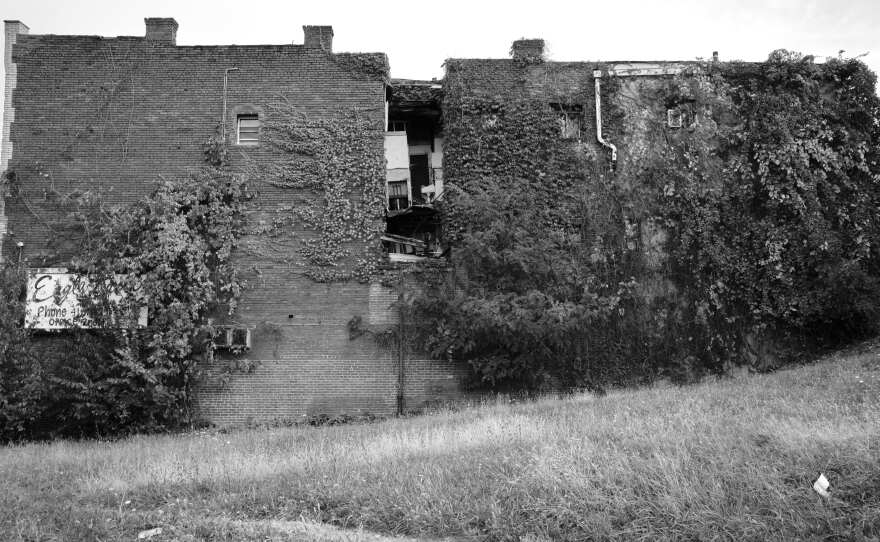In any city, change is inevitable. But for Black Pittsburghers, change often feels far from neutral. In her new photography book “This Is Where We Find Ourselves,” local artist Njaimeh Njie explores the displacement of Black Pittsburghers through the story of her own extended family.
Njie’s mother’s family came north from North and South Carolina. Some ended up in the Homestead neighborhood known as the Ward, which in 1941 was leveled to make room for U.S. Steel’s expanded Homestead Steel Works. Others lived in the Hill District, part of which itself was later infamously demolished to permit construction of the Civic Arena.
Njie herself grew up in the 1990s and early 2000s, in Stanton Heights, but even many of the touchstones of her youth have vanished – her alma mater, Schenley High School, is now condos, and the East Liberty business district she frequented has been gentrified past recognition.
The 80-page book, a limited-edition paperback publication by the Silver Eye Center for Photography, is the result of a Heinz Endowments grant Njie and Silver Eye received to respond to the events of 2020, including the coronavirus pandemic and the wave of protests for racial justice. In her sparse, poetic text, Njie notes those historical events. But most of the book consists of photos – primarily, Njie’s stark, black-and-white urban landscapes of the desolate or abandoned parts of neighborhoods, interspersed with family snapshots from the 1930s to the 2000s.
“One thing I noticed as I was making pictures for this project last summer [in 2020] was that even in this time of uncertainty, even in this time of chaos, even in this time where so many people were losing finances and losing their livelihood, the city was building itself up and making itself over,” said Njie. “And that made me think a lot about erasure, that made me think a lot about displacement, that made me think a lot about how things change and how things are forgotten. And so I wanted to take a moment, this very specific moment in history to think about what things are and how things are right now before they continue to change even more.”
Years after new developments (or simply empty space) took the place of the Homestead Works and the Civic Arena, the city is still struggling to heal the wounds caused by the original displacements, especially in the Lower Hill. And the parade of bulldozers and wrecking balls that’s remade neighborhoods like East Liberty with boutique shopping and pricey new apartments feels like an ongoing trauma to Black folks, Njie said. In the 2010s, according to the U.S. Census Bureau, the city’s Black population declined by 13.4 percent, or by more than 10,000 people.
“There's a legacy of displacement of Black people, of Black communities in the city of Pittsburgh ... It feels like there's this generational loss that's inherited. I think my question for the city is, ‘Why do we as Black folks continue to have to inherit this loss?’ Because it’s not that we don’t make community, it’s not that we don’t continue to love each other and look out for each other. It's that generation by generation there are systemically fewer places for us to make that community together.”
The title of “This Is Where We Find Ourselves” suggests not only our arrival at a certain moment in history, but also the way that place forms identity. In its pages, Njie also recalls the 1950s Homestead of her mother and her siblings — “[t]ag in the alley, jacks on the porch, playground summers, Saturday matinees” — as well as her own childhood decades later: “It-tag and riding bikes, loose change for the ice cream man, and slow walks to talk about everything and nothing at all.”
Njie works to document the history that’s being lost. In 2018, when she was named Pittsburgh Center for the Arts’ Emerging Artist of the Year, she curated a multimedia exhibit titled “On the Daily, blackness in a changing city.” In 2019, she installed “Homecoming: Hill District, USA,” a mural honoring Hill neighbors going back generations, which she completed after a year of conducting oral histories and other research.
“In my work, I do try to really shine light on and celebrate the many different ways that Black folks experience and move through our lives here in the city, not just now, but in a historic sense too,” she said. “I think that it's interesting that a lot of the local narrative about Pittsburgh is so white because the Black history here is so rich, and I do not think that you can talk about the history of Black America without coming through Pittsburgh. There have just been so many people that have made tremendous contributions to not just Black American culture, but what Black culture is worldwide.
“And so if I can, you know, contribute a little bit to that narrative, to just celebrating who we are and what we've done, not just in the grand, you know, history-book sense, but in the day-to-day community sense, then that's work that I feel very privileged to do.”
The initial press run of "This Is Where We Find Ourselves" sold out, but the exhibit version of the project is on display at Silver Eye through Feb. 19.









